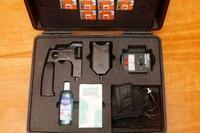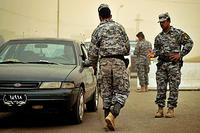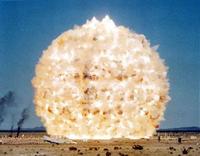-
Pennsylvania emergency professionals receive WMD training
The Center for Domestic Preparedness (CDP) in Alabama hosted more than a hundred emergency professionals from the Pennsylvania South Central Mountains Regional Task Force’s Health and Medical Committee for in-depth response-to-WMD training.
-
-
Terahertz technology helps to see more with less

Terahertz technology is an emerging field which promises to improve a host of useful applications, ranging from passenger scanning at airports to huge digital data transfers. Terahertz radiation sits between the frequency bands of microwaves and infrared radiation, and it can easily penetrate many materials, including biological tissue. The energy carried by terahertz radiation is low enough to pose no risk to the subject or object under investigation.
-
-
Reducing the volume of nuclear waste
The nuclear industry seeks to minimize the volume of nuclear waste by extracting the radioactive elements from spent fuel.This relies on exploiting differences in the chemical bonding of uranium. Scientists have found that in some circumstances the bonding may be surprisingly similar, an important discovery which is going to be important in the amelioration of nuclear waste clean-up and devising new atom-efficient catalytic cycles.
-
-
U.S. sharply disputes UN official's claim that Syrian rebels used chemical weapons
The United States sharply challenged claims by a UN official – who is not a member of the UN investigative commission looking into to the possible use of chemical weapons in Syria – that the rebels, rather than the Assad regime, used sarin nerve gas near the city of Aleppo on 19 March. The UN investigative commission looking into the incident distanced itself from the official’s comments.
-
-
U.S. policy may lead to growing global shortage of helium

Helium is an essential resource in technologies such as medical imaging, rocket engines, and surveillance devices. In response to the element’s scarcity, the United States has been stockpiling helium since the 1960s in a National Helium Reserve called the Bush Dome, a deep underground reservoir outside of Amarillo, Texas. In 1996 the Helium Privatization Act mandated that the Department of the Interior sell off all the stockpiled helium by 2015. Scientists say that this action discourages the active exploration of helium since companies can buy it from the United States at a cheap price and sell it at a premium. The result will be a growing shortage of helium.
-
-
Kenya police: (fake) bomb detectors work, making Kenyans safer

A British businessman was convicted of selling Iraq and Afghanistan fake bomb detectors – the two countries used millions of dollars in U.S. aid money to purchase the sham devices (the devices were, in fact, $20 golf ball finders which the businessman sold for $40,000 each). The police in Kenya purchased twenty-six of the sham detectors, but Nairobi police chief says the devices work, and that Kenya is safer for them.
-
-
U.K. businessman convicted of selling fake explosives detectors

James McCormick, a British businessman, was convicted of having made millions in profits from selling fake bomb detectors to Iraq, Georgia, and several other countries. McCormick bought $20 golf ball finders in the United States, then sold the devices, which had no working electronics, for $40,000 each. The Iraqi government used more than $40 million in U.S. aid money to buy 6,000 of the devices, despite being warned by the U.S. military that the devices were a sham. The Iraqi military used the fake detectors at check-points, leading to scores of soldiers and civilians being killed by suicide trucks which went through the check points undetected. The police in Kenya says it will continue to use the devices.
-
-
New fertilizer can be used to grow food – but not build bombs

Ammonium nitrate fertilizer is used in agriculture, but when mixed with a fuel such as diesel, it is highly explosive. It was used in about 65 percent of the 16,300 homemade IEDs in Afghanistan in 2012.About 1,900 troops were killed or wounded in IED attacks in 2012, 60 percent of American combat casualties. There have been more than 17,000 global IED incidents in 123 countries in the past two years. Timothy McVeigh used ammonium nitrate in Oklahoma City in 1995. Scientists have developed a fertilizer that helps plants grow but cannot detonate a bomb.
-
-
Ammonium nitrate fertilizers are inherently risky, but the benefits are many
The deadly explosion has brought the $10 billion U.S. fertilizer industry to the attention of the mainstream media, but the risks inherent in fertilizer production and storage are not a secret to people close to the industry. Ammonium nitrate may be dangerous, but its benefits cannot be ignored.
-
-
New detection test to improve food safety, bioterrorism defense
Sales of chicken products in China plummeted recently during an outbreak of a deadly new strain of bird flu. From bird flu to mad cow disease, numerous food scares have made global headlines in recent years.Scientists develop new detection technique which wouldmake food contamination testing more rapid and accurate. The detection test could also accelerate warnings after bioterrorism attacks.
-
-
Mississippi man arrested for sending ricin letters to Obama, Sen. Wicker
The FBI confirmed yesterday (Wednesday) that a letter addressed to President Obama was found to contain the toxin ricin. As is the case with all the mail sent to the White House, the letter was screened in a remote mail sorting facility in Anacostia, a neighborhood in southeast Washington, D.C., and intercepted. The FBI arrested a man from Tupelo, Mississippi, on suspicion that he was behind the ricin letters to the White House and to Senator Roger Wicker (R-Mississippi), who lives in Tupelo.
-
-
Energy Department to invest in used nuclear fuel storage research
As part of its efforts to develop an effective strategy for the safe and secure storage and management of used nuclear fuel, the Energy Department the other day announced a new dry storage research and development project. In the Energy Department’s budget request presented last week, the department requested $60 million for nuclear waste research and development.
-
-
Experts will meet in September for the bi-annual anthrax research conference
More than 300 scientists and researchers from all over the world who work on Bacillus anthracis, the causative agent of anthrax, and B. cereus and B. thuringiensis, two closely related bacilli, will be heading to Victoria, British Columbia for the Bacillus ACT 2013 conference, which will be held 1-5 September.
-
-
Former NRC chairman: all 104 U.S. nuclear reactors suffer from “irreparable” safety issues
According to former U.S. Nuclear Regulatory Commission (NRC) chairman Gregory Jaczko, all 104 nuclear reactors in the United States currently have irreparable safety issues and should be shut down and replaced. Jaczko was the NRC chairman from 2009 through 2012.
-
-
Critics: Fukushima-influenced U.S. nuclear accident response procedures are flawed
The U.S. government is using the Fukushima nuclear disaster in Japan two years ago as a model for rewriting its plans on how to respond to radiation contamination — emphasizing long-term cleanup and return of residents to affected areas instead of emergency response. Critics say this is a mistake.
-
More headlines
The long view
Keeping the Lights on with Nuclear Waste: Radiochemistry Transforms Nuclear Waste into Strategic Materials
How UNLV radiochemistry is pioneering the future of energy in the Southwest by salvaging strategic materials from nuclear dumps –and making it safe.
Model Predicts Long-Term Effects of Nuclear Waste on Underground Disposal Systems
The simulations matched results from an underground lab experiment in Switzerland, suggesting modeling could be used to validate the safety of nuclear disposal sites.
